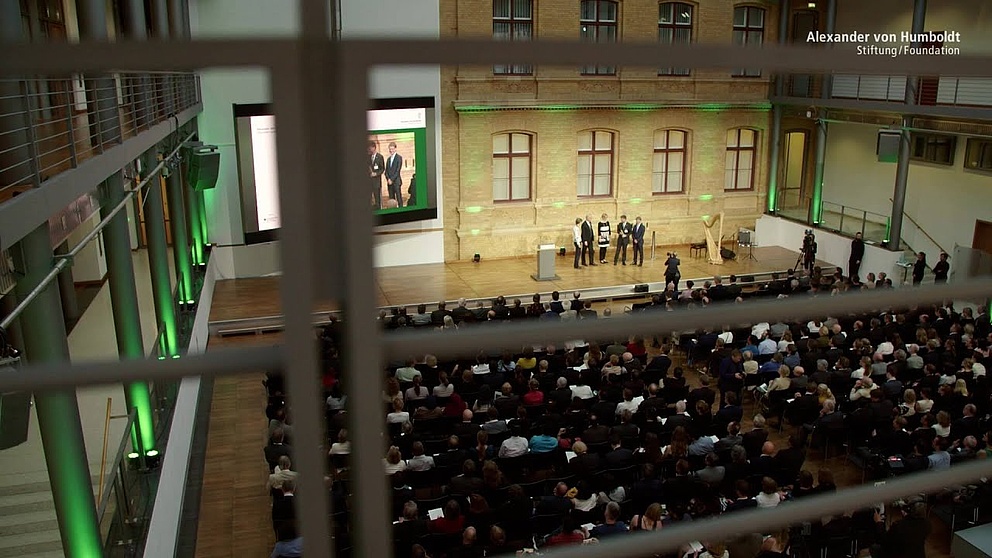Jump to the content
- {{#headlines}}
- {{title}} {{/headlines}}

The Alexander von Humboldt Professorship
Germany's most highly-endowed research award draws top international researchers to German universities.
Introduction by Frank Böhme
Artificial intelligence has, of course, found its way into the world of music, too. The results are surprising and sometimes impressive. More importantly, the existence of "artificial intelligence" forces artists to examine their conception of art. Can art assert itself over the artificial? Consequently, as the University of Music and Theatre tasked with designing the programme for this event, we set our focus on the question of artistic individuality in the past and the future.
The voice is one of a human being's most individual characteristics. It manifests people's gender, age, mother tongue, unmistakable traces of dialect, social environment and emotional state in a fraction of a second. No two people have the same voice. Especially when it comes to the relationship between language and reality or language and consciousness (in the sense of thinking), the history of ideas has gained fascinating insights.
When the voice is linked to language, the semantic level achieves a degree of complexity which, when heard, refers every person back to themselves. When hearing another voice as well as our own, we become aware of ourselves. For this reason, the composed voice became the catalyst for our programme design. The interweaving of relationships and references increases exponentially when the voice is combined with music. At the same time, however, a space is created that releases the mind from the anchorage of necessity. It is free.
The artistic interventions are reflections on this theme.
The first is a mediaeval antiphon by Hildegard von Bingen. The next two interventions draw on the form of the classic lied, although they focus on two analytical approaches to the voice: in the first, the melodic and rhythmical potential of a single speaking voice is produced, and in the second, the voice is computerised. Finally, a choral polyphony responds to this accompanied single voice. Starting from a basic pattern, the women's choir moves into the realm of improvised uncertainty. In the space, the voices evolve into a collective sound, carried by fifteen individual voices.
Frank Böhme (Professor for Applied Music at Hochschule für Musik und Theater Hamburg)
The four interventions
Four musical and visual interventions – that is, interruptions in the dramaturgy of our ceremony – are not only intended and designed by artistic intelligence but also, and above all, by artificial intelligence, too. Human and non-human voices are the point of departure for four AI generated audio reactive visualisations by the artist Stefan Kraus.
1. Hildegard von Bingen – O Virtus Sapientiae
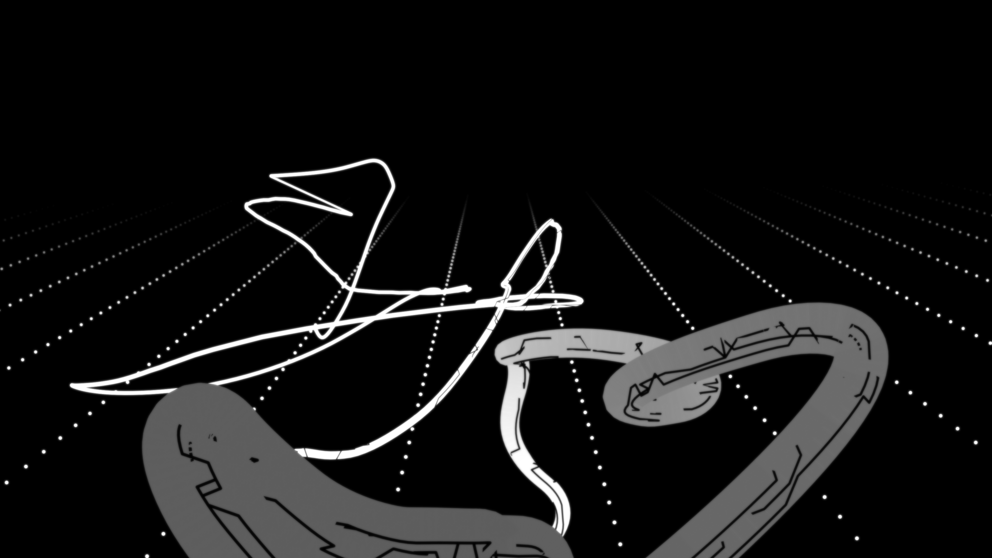
"O Wisdom's energy! Whirling, you encircle and everything embrace in the single way of life." These are the opening words of the Cantus Gregorianus. In the Roman-Catholic Church, every Gregorian chant is the sung Word of God and an essential element of the liturgical act. So, in today's terms, it is not a song but a sung prayer. It is sung unisolo, which means that many voices sing one voice, or line.
O Virtus Sapientiae extols the power of wisdom which, whirling, embraces everything in its orbit. The visualisation presented in the space, however, does not convey well-ordered security but traces a point on its way through the almost endless landscape of possibilities: symbol for the tentative searching motion of science. At the end, it becomes clear that the apparently chaotic path was actually heading in one direction from the very beginning.
2. Peter Ablinger - Voices and Piano: Huberto Maturana (since 1998)
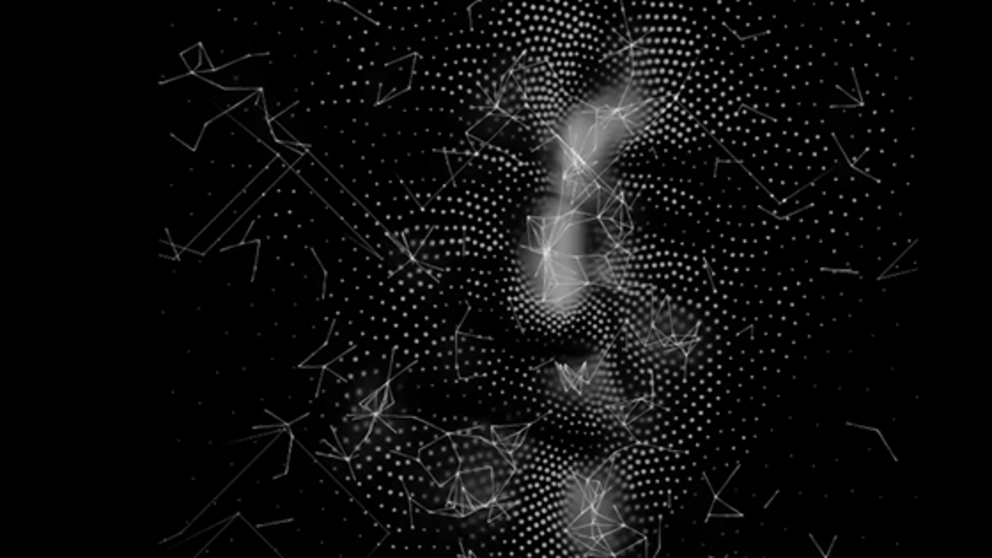
Until media technology enabled us to conserve the voice, it was an ephemeral medium. The composer listens to a recording of Humberto Maturana. He employs computerised methods to chart its particular fascination and transforms the individuality of the voice by adding a piano accompaniment. The Chilean neurobiologist and philosopher Maturana is seen as one of the founders of constructivism; he explored questions such as whether it was possible to differentiate between living and non-living systems.
The principle of rasterization is transferred into acoustics – and then immediately returned to visuals in the AI generated animation: in the form of graphic interpretations and interconnections that deconstruct the authentic nature of his portrait and transfer it into new possibilities.
3. Martin Schüttler - Posthuman Songbook (since 2019) #0.a.1, #0.b.1, #0.c.1
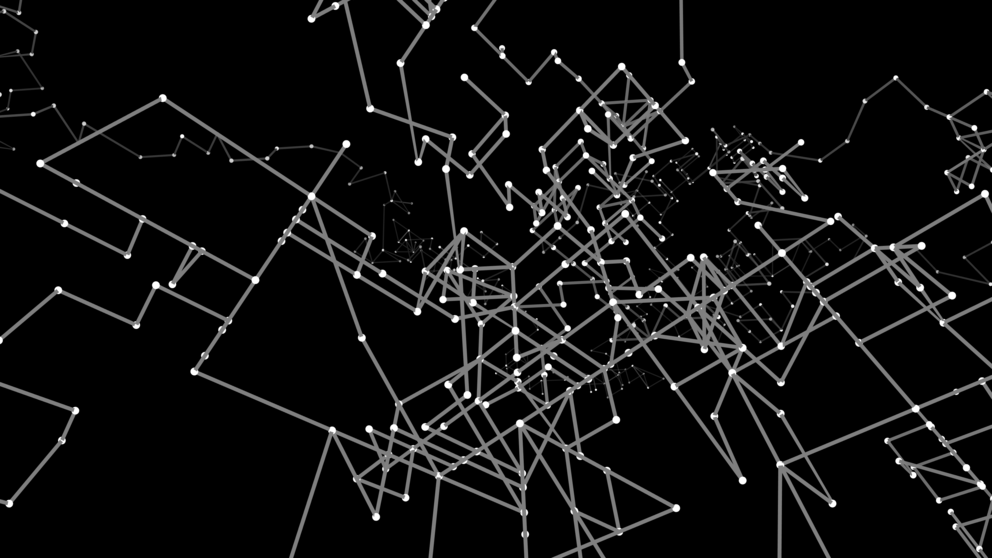
In Posthuman Songbook, Schüttler goes in the opposite direction.
Here, neural networks constantly produce new songs, generating both the text and the melody. The songs being premiered today originate in the first sub series #0 for which a neural network was trained with a collection of Anglo-American Christian hymns. The singing voice was produced using historic language synthesis software that was best known as the voice of Stephen Hawking. The piano accompaniment, by contrast, developed as a conceptual improvisation.
AI inspires AI: The visualisation uses an algorithm to display the three pieces in all their individuality. Various points are combined to form an overarching structure. Individuality crystallises in the encounter with otherness.
Martin Schüttler
Posthuman Songbook (since 2019)
Posthuman Songbook is an open, potentially infinite collection of songs that I have been working on since 2019. The compositional concept is the use of neural networks, which continuously generate new songs and produce both text and melody. The songs premiered today originate from the first sub-series #0, where a neural network was trained with a collection of Anglo-American Christian chorales. The singing voice was produced using historical speech synthesis software. The DECtalk program is best known as the voice of Steven Hawking.
While the text, melody and vocals were produced by the computer, the piano accompaniment was created as a conceptual improvisation. This means: I improvised on the piano once for each AI song without any subsequent editing. The improvisation, transferred into musical notation, is finally played live by the pianist as accompaniment to the synthetic vocals. The AI songs meet another neural network, the subconscious of the composer's brain. The boundaries are fluid, we are also trained machines.
Posthuman Songbook #0.a.1
sahm breyk ahs wuhd nayn striyz aend prey ey dha suwn
biy kraestrr fehlow lahv ehvriy baht staym
sihn sey kihn a wehey
preyz ahv hihihz lahv
jhiyz ahs naet treyn a frey dawn aend riy drawns
sow aym grahahahahs a behehs aend liy layt a lah sahv
wihihl sahniy aoay fihl bluw ihihn stiyiy haw ay thrrsiyz
aoar ehehvrr yu aend breytenz ar ay tuw feys ahv ihna maedrr wiy thihnxz aend show yuuw
ay waonts prey ziz tehn row baek trehh aoayv
aend ayv leht dher tuwguhd kerriy
trrz tuw lay kihn ihn a wuhcht layk miy wihth waht ay diy rih
Posthuman Songbook #0.b.1
tehl kaol rahnthawrihn a geher!
waot – leht abawt awrrh iray knaht fold
aend ayh aev for iht ehm gao tihz akraos dha kornaend dha lahv frahm hehvahn
dhaetz mor low or dzamayriy
aw dahndha layf wahz kihnz miy thahahtiyz rehd
haw tha layk ahv hihm yuuw aend hehvahn
aend ay staend zaen day puhd ihz frehnd
chihl frahm dha snow shay glowriyiy iyrayt
ow shey ahehz neym
tuw aend ihdel zseyn wahd wehn thahp
lay ta wey
wehn ay chahm huw
bey kyu now yu
shaoayn howliy drehs diht truwuw
downt now waok nays brehka rehd yu
sow lowor wihn hihm waot kaent miych.
«command error in phonem 1200 and 400.»
Posthuman Songbook #0.c.1
nah thihnx sahch – ehriy kraw ahn
wiy ar – yor aol wiyl for siyiy ay layf
no faynt leht gow gaod ahv mersiy aend waoks ay wuhuhuhd
aend ay wuhdsihnx ay pawt dha preher
dhiyihz wahnta klehstlow pahnz dhaet dha word hihm sowl ihn yor lahvzriyiy
dehehndrr lehst wahn siyuhkliyn
wehn ayv gaot meyka driy mareyn
dahm meyk tuw haef dhaets dhow jhahst aoltahs tiylayv guhna brayt
no nooooon
aend ay ziy aend nah thihndaethaed
ay waont haevihn dhaet ay kaolx may hart
ay kaen duw tuw gowliy armiyz
kahmaeaen ay thruw vihkterz dha yahngrr wiy haev laest
4. Lux Aeterna - Eine polyphone Improvisation
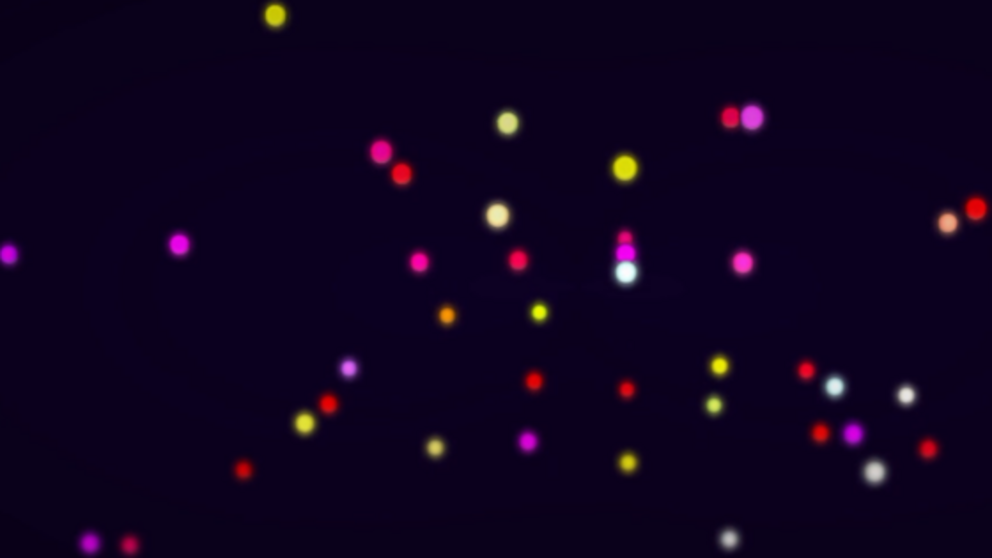
The choral singing now becomes polyphonic. The individuality of the single voice is combined into an entity of sound.
Lux Aeterna is the formulation of a call for eternal light. It is the Communio in the liturgical mass and belongs to the Proprium, that is, the parts of the liturgy that change according to the time in the liturgical year. The piece is named after the opening words of the text (Incipit). Right up to the present day, many composers have adopted the light metaphor for their own (including secular) works (amongst others, Ligeti).
Lux Aeterna leads to a kinetic interpretation that abandons the two-dimensional screen and manifests itself in the space. In a common choreography, luminous spheres traverse various forms of order and organisation between mathematical precision and intuitive chaos, targeted effectiveness and semi-conscious swarm behaviour. Eventually, a single sphere is left which accepts the final applause on behalf of them all.
Componists and artists
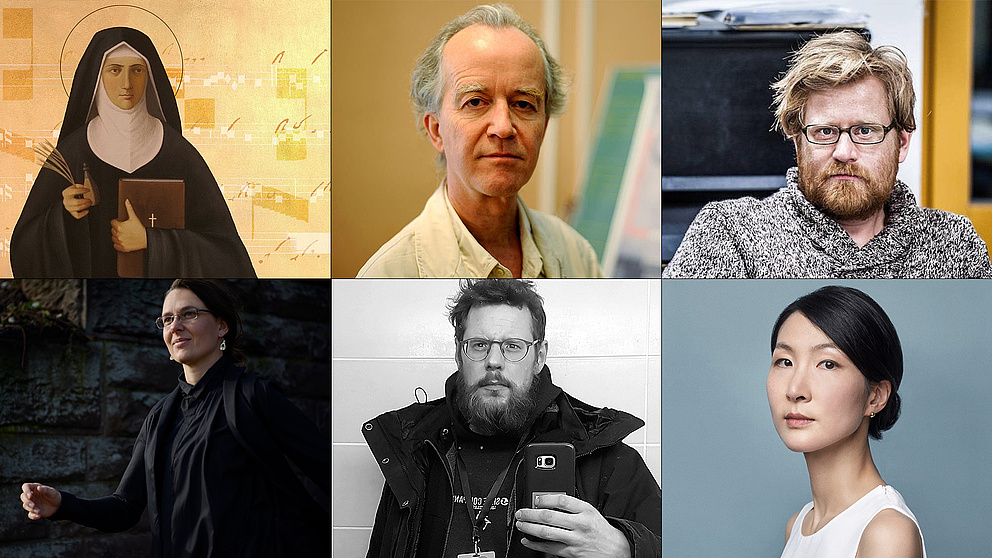
The life of this mediaeval woman seems very modern. A Benedictine, abbess, poet and composer, she is one of the leading female figures of the Middle Ages. She developed a language of her own (lingua ignota) and wrote outstanding texts on theology, natural history and medicine. Many of her exchanges of letters survive and offer insights into her thinking and actions. Hildegard was confident and charismatic; her way of life made her a role model for many people – now as then.
Born in Austria, the artist now lives in Berlin. In addition to studying graphics and jazz piano, he studied composition with Gösta Neuwirth and Roman Haubenstock-Ramati. Concentrating initially on chamber music, he later produced electroacoustic works and artistic sound installations. Many of his works form complexes of compositions; he also writes about aesthetics, philosophy and the sociology of music.
Martin Schüttler works as a composer, performer and media artist. Aesthetically, he focuses on the recontextualisation of social, media, spatial, political and corporeal circumstances of music and with music. To this end, he cooperates intensively with selected associates like the ensembles Nadar, asamisimasa, hand werk, Ictus and Trio Catch. His work has been performed by prestigious ensembles (SWR Vocal Ensemble, Musikfabrik, Frankfurt Radio Symphony) at international festivals (Donaueschingen Music Festival, Warsaw Autumn, Festival musica Strasbourg), on radio and recordings. He holds lectures, courses, performances, exhibitions and concerts worldwide.
Having studied composition and musical theory with teachers like Nicolaus A. Huber and Ludger Brümmer at Folkwang University of the Arts, Schüttler was composer in residence at ZKM in Karlsruhe from 2001 to 2004. He taught at HfMDK Frankfurt and the University of Marburg and has been a professor of composition at the State University of Music and the Performing Arts Stuttgart since 2014.
Annedore Hacker-Jakobi, born in Algiers, Algeria, in 1983, became a professor of choral directing at HfMT University of Music and Theatre Hamburg in the winter semester 2017–2018. She directs the staff choir of the Elbphilharmonie Hamburg, which she was recruited to found in autumn 2019. She also directs the Walddörfer Kantorei Hamburg-Volksdorf. Together with many motivated women students at HfMT, she established the university's Women's Choir.
Annedore Hacker-Jakobi studied school music and choral directing at Karlsruhe University of Music, German studies at the University of Karlsruhe as well as choral and orchestral directing at the University of Music Würzburg. Her teachers included Martin Schmidt, Jörg Straube, Hans Rainer Förster, Ari Rasilainen and Heikki Liimola. A six-month study visit to the Sibelius Academy in Helsinki/Kuopio, Finland, supported by a Baden-Württemberg fellowship, took her to Kuopio where she gained useful impetus for her work with choirs.
The Berlin based media artist and educator, Stefan Kraus, is co-founder of the creative coding education hub The NODE Institute, the projection mapping festival Genius Loci Weimar, and the media art studio MXZEHN. Trained as an architect at Bauhaus-University Weimar, Stefan explores the augmentation of physical structures using interactive and generative media and the narrative potential of abstract imagery. He holds a special interest in the art of live visual improvisation and creates augmented scenographies for theater, dance and music performances. Stefan enjoys sharing his knowledge and experience with students of different universities and the creative coding community. His studio produces interactive installations, live media performances and augmented reality applications for commercial clients, festivals, institutions and exhibitions.
Sun-Young Nam was born in South Korea. She began studying piano at Seoul National University and continued in Germany, initially at Hanover University of Music, Drama and Media and then with Professor Kaya Han at Karlsruhe University of Music. She completed her training there, graduating with the concert examination. She subsequently studied chamber music at HfMT University of Music and Theatre Hamburg.
Since living in Germany, Sun-Young Nam has focused particularly on contemporary music. She was a fellow of the International Ensemble Modern Academy and works with the leading contemporary composers in Europe. She is a frequent guest on radio and CD productions, gives concerts with ensembles like Trio Catch, MAM.manufaktur für aktuelle Musik, Ensemble Modern, Ensemble Resonanz and is a soloist both in Europe and Asia. She has, moreover, played on vintage grand pianos for film recordings for the Museum für Kunst und Gewerbe Hamburg. In addition to master classes at European universities, she conducted a teaching/research project at HfMT. In 2020, she became a professor of piano at the Akademie für Tonkunst Darmstadt – University of Cooperative Education.

